|

| Photo
Copyright 2005 |
| David
Xavier Kenney |
|
ROMAN SENATORIAL GOLD BAND RING OF A RECIPIENT OF THE CORONA CIVICA UNDER SULLA |
Material: Gold
Era:81 to 82 BC
Culture: Roman
Style: Roman
Origin: An Antiquities Dealer from New York
There is new information on the outside of the ring. Around the entire ring there are light engravings of a wreath with various figures intertwined, it is extremely worn. It may have been lightly engraved as to have the wreath motif known only to the wearer, at any rate it will not appear when photographed. There is also new information with the inscriptions and art on the inside of the ring, as there has not yet been an attempt to photograph these, then there are currently no pictures with this information: It specifically shows that the original owner of this ring had been an Optio Centurionis (a second to a Centurion) when he received this gold band ring along with the Corona Civica (Civic Crown) during the dictatorship of Sulla. This hints that the gold band ring of the aristocrats may have replaced the iron band ring (if there ever was such a thing) of the same under Sulla. The images are precise, so it can be speculated that it was policy at least under Sulla that the gold band ring was awarded along with the coveted Corona Civica award. The Corona Civica was the highest Roman award for individual bravery, it was awarded to Romans only for saving the life of a fellow Roman in action, that is while taking and holding that specific ground until the completion of the battle. There is also an image of a bare headed legionary wearing torcs, armilla, and a large phalera. So it can assumed that the Optio had also received these awards at that time, or earlier on.
The ring is an American size 9 3/4. There were two classes of Romans who wore "The Gold Band", those of the Senatorial class (the Nobles) and those of the Equestrian class (the Roman Knights or lesser Nobles). The following can be seen with the pictures provided: Picture 1 shows the ring itself. There are two areas on one side of the ring's edge that have engravings seen with the followig pictures. Picture 2 shows an animal's head, it may be a horse or a deer's head. There are figures behind this that may symbolize the hunting of that animal. Pictures 3 and 4 show small figures and the letters "M' and "R". Pictures 5 and 6 show a man's face in an Roman Attic helmet. On the helmet's crest there are several stacked figures, the bottom figure is in a balcony that is also the helmet's visor. Under the face there are the Roman letters "ARO", this should be a Roman reference to ploughing. Therefore the symbolism must be of Romulus and his ploughing of a square (in order to found Rome). The figures overhead may be either ancestors, semi-divine, or celestial figures. Picture 7 shows a boy in a conical hat, this should be a Penates or Lares. The following depictions and inscriptions are not seen with the pictures provided. Although somewhat worn, it has miniature art on the inside, with this there are Roman letters and one large Etruscan or Oscan figure eight letter (thought to be for the Roman letter "F"). This figure eight letter is also made as a bear drinking from a cup, when slightly turned the bear will change into a wolf. In the bottom loop there s a boy's face. Next to this are Roman bind letters. The letters appear to be an abbreviation for the "Aventine". When turned slightly the letters will change and appear as an abbreviation for the Palatine. When seen upside down, it is a boy holding a crested bird (wood pecker). When seen from one side, it is two semi-coiled serpents. Finely when seen from the other side, it is a serpentine man with an unknown serpentine animal. It is evident that the two boy figures are Romulus and Remus and that the two serpents are symbolic of the Aventine and Palatine hills. There are other depictions and inscriptions, one of the inscriptions is the "S C" (Senatus Consulto) of the Roman Senate. In legend the Roman Senate originated as a councilor group to Romulus.
Copyright 2008 David Xavier Kenney
Revised Nov 08, Jan 010
|
|
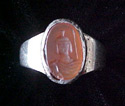
| Photo
Copyright 2005 |
| David
Xavier Kenney |
|
PRAETORIAN GUARDSMAN'S RING (COMMEMORATING THE SIEGE / BATTLE OF JERUSALEM OF THE 1ST REVOLT)
|
Material:
Silver Alloy, Carnelian, and Trace Amounts of Niello
Era: 71 AD to Early 2nd C. AD
Culture: Roman
Style: Roman
Origin: An Antiquities Dealer in New York
This is a silver alloy and carnelian Roman intaglio ring that belonged to a Praetorian Guardsman. The ring is an American size 11. The ring appears to be initialed by the intaglio maker.. On the ring's band is art that commemorates the Siege / Battle of Jerusalem of the 1st Revolt; it is made in a scratch and dotted graffiti style. There are various inscriptions, two of these are abbreviations of the Praetorian Guard (P PR) and Legion XV Apollinaris (LEG XV AP). The art and technique on the intaglio is highly sophisticated. It was done with various levels of very refined miniature work and a gold wash. The primary work done on the bezel is of the Praetorian's unit II Cohors Praetoria. The bezel's outer portion is as a whip that is a scorpion's tail (thought there is much more with the miniature art on this). The scratch work on the bezel is of the Siege of Jerusalem during the 1st Revolt, apparently the Praetorian Guardsman that owned this ring was with Titus. The other more miniature work on the bezel and the intaglio is of some type of mystery belief, it appears to be of the Sybil of Cumae, Augustus, and the his first Imperial Praetorians. It could be suggested that II Cohors Praetoria had a detachment at the Praetorian Naval Base at Misenum as besides the Sybil they appear to have had a connection to the sea.
Copyright 2008 David Xavier Kenney
Revised Nov 08
|
|

| Photo
Copyright 2008 |
| David
Xavier Kenney |
|
Ring Detail 1
|
This group of pictures shows miniature art work in and on the carnelian (possibly done with a tint or reflection from the bottom of the stone) and on the bezel. The darker area near the Praetorian's helmet is the head of a lioness, it also hints of a bear's head. The break in the bezel in the front shows work that is reflected from the top of the bezel and the light coming through the stone. The break has a sword fish attacking another creature with smaller figures on it. There is a hint of a sea conflict. A section of the carnelian hints of volcanic larva.
|
|
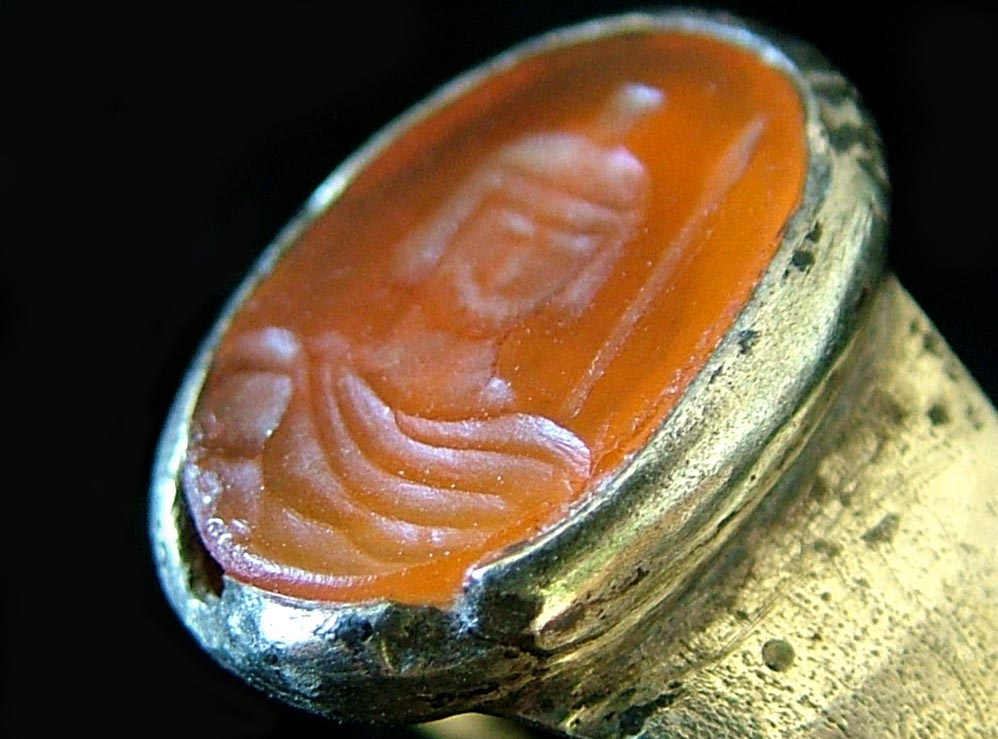
| Photo
Copyright 2008 |
| David
Xavier Kenney |
|
Ring Detail 2
|
This group of pictures shows miniature art work on the bezel's breaks on the front and on the side. The side's break show more of the same sea conflict or another sea conflict.
|
|
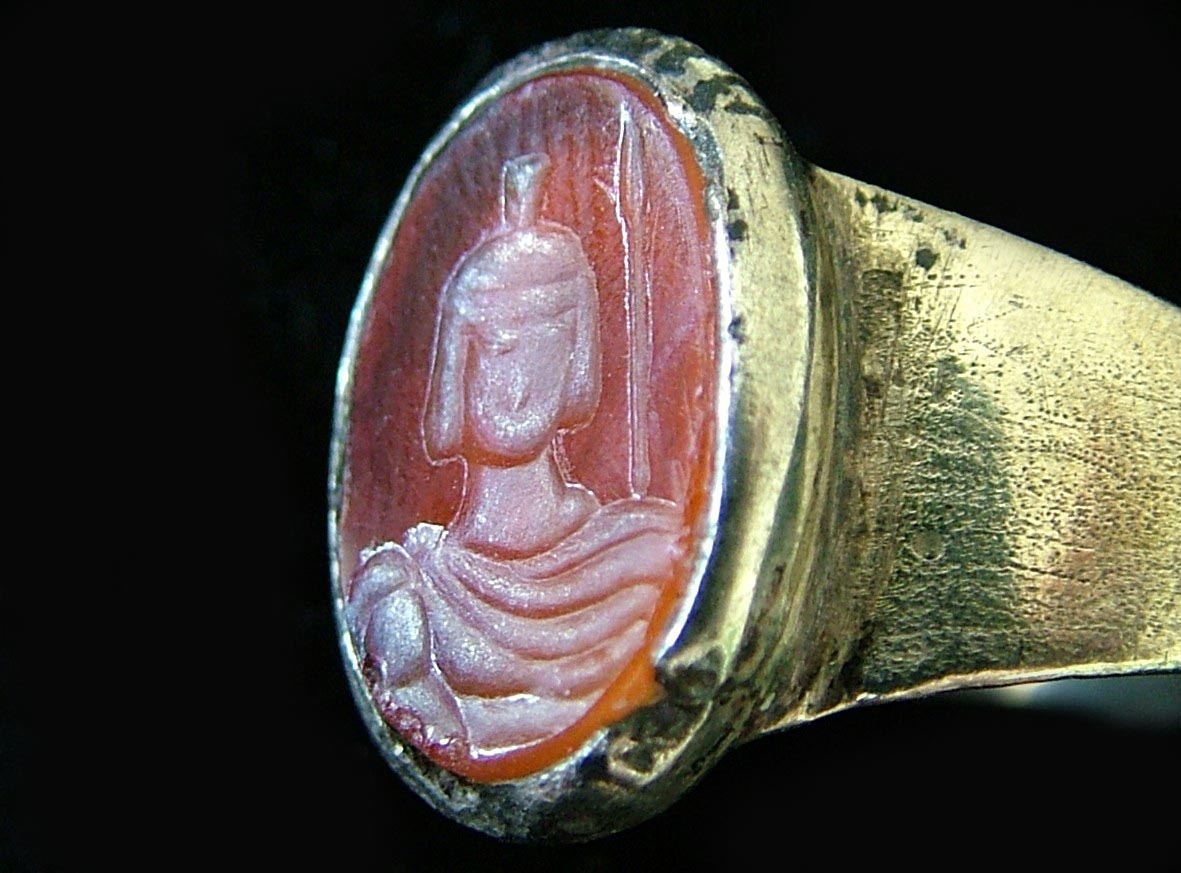
| Photo
Copyright 2008 |
| David
Xavier Kenney |
|
Ring Detail 3
|
This group of pictures shows the following; more detail of the work on the intaglio, the bezel top, the intaglio upside down, and the bezel on each of it's sides. The first pictures show from an angle that there is detail work done in wax. On the top of the bezel there is a small figure on a bottle nosed dolphin, the figure has a sword or a trumpet (possibly representing both of these). With this Picture 6 shows that the figure of the dolphin is attacking either a bear or a bear's head*. On the intaglio there detail on helmet's crest, like most miniature art the art will transform when moved. It shows more detail of the lioness/bear's eye that is also V-slot on the front of the helmet crest. Picture 3 shows this area as a woman's face, Picture 5 shows the same area as somewhat like a barn with a key hole (or person in front), Pictures 8 and 9 show this same area as a vertical axe head with a face on each side, there is a large letter "A'. The next pictures show the bezel and intaglio upside down. Pictures 12 and 13 shows a figure with a mustache and beard, his arms are crossed while holding in each hand an upright club, he is in a cup that has a stem. Over this figure is a type of chimney with smoke that appears as a horse with a round nose (this type of horse symbolism is seen in other examples of Roman and Germanic miniature art, it may represent a larva stone from a volcano, or a meteor, or a comet), at another angle the horse transforms, it can be seen as a horse holding something. There is an opening on the bezel overhead. Pictures 22 thru 25 show the detail of the opening, it is as a cave with lava, (in my opinion this lava cave is connected to the Sybil of Cumae), flowing out of it, there are figures on each side. Pictures 26 thru 30 show the detail of the figure with the crossed arms holding two clubs, with these Pictures 27 thru 29 show that the club seen on the right appears as a stake. On the face there is a scene with two facing figures and a third figure in the middle. Pictures 31 thru 35 show the intaglio on one side, there is a scene on the face, the spear is overhead. The overhead spear to the Romans usually symbolized a defeat, although in this instance it may represent the evening. Pictures 37 thru 39 shows the intaglio on it's other side. There is a different scene with figures, the spear is under this
Summery of what is seen on the bezel and the miniature art on the intaglio: Although this mystery is not completely understood it appears that it is associated with three goddesses; Diana (bear), Venus Victrix (swordfish), and Cybele (lioness) through the Sybil of Cumae. With gods it appears to be associated with Apollo (but also Sol Indiges) and Hercules. This also has to do with a volcano (Vesuvius) or volcanoes (Vesuvius and Aetna), the straights of Messina (swordfish). There is some kind of a northern connection with all this. There are a few suggestions that they may connected this to stories of the volcano on the island of Thule (Hekla of Iceland). My research shows that the Romans and perhaps others believed that all volcanoes were connected by underground rivers of lava.
Copyright 2008 David Xavier Kenney
Revised Nov 08, Jul 09
|
|
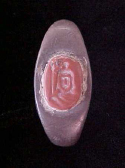
| Photo
Copyright 2005 |
| David
Xavier Kenney |
|
PRAETORIAN
GUARDSMAN'S RING |
| Material:
Silver and Carnelian
Era: Late 3rd Century AD
Culture: Roman
Style: Roman
Origin: An Antiquities Dealer in the Netherlands |
|
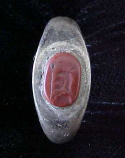
| Photo
Copyright 2005 |
| David
Xavier Kenney |
|
PRAETORIAN
GUARDSMAN'S RING |
Material:
Silver and Carnelian
Era: 276 AD
Culture: Roman
Style: Roman
Origin: An Antiquities Dealer in the Netherlands
|
|

| Photo
Copyright 2005 |
| David
Xavier Kenney |
|
ROMAN PRAETORIAN
LIONESS INTAGLIO SIGNIFIER'S RING |
Material: Bronze
and Carnelian
Era: Intaglio, 1st to 2nd Century AD - Ring, 3rd Century AD
Culture: Roman
Style: Roman - Roman Provincial
Origin: An Antiquities Dealer from New Jersey |
|
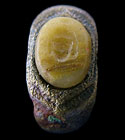
| Photo
Copyright 2007 |
| David
Xavier Kenney |
|
ROMAN BOY'S FAN RING OF THE PRAETORIAN GUARD |
Material: Bronze
and Carnelian
Era: 3rd Century AD
Culture: Roman Provincial
Style: Roman Provincial
Origin: An Antiquities Dealer from New Jersey |
|

| Photo
Copyright 2008 |
| David
Xavier Kenney |
|
ROMAN LEGIONARY RING OF I ITALICA |
| Material:
Silver and Mercury Alloy
Era: Late 1st to 2nd Century AD
Culture: Roman
Style: Roman
Origin: An Antiquities Dealer In Germany. From an Old German Collection
|
|

| Photo
Copyright 2008 |
| David
Xavier Kenney |
|
ROMAN LEGIONARY RING OF THE II ADIUTRIX |
| Material:
Bronze
Era: 2nd Century AD
Culture: Roman Provincial
Style: Roman
Origin: An Antiquities Dealer in New Jersey
|
|

| Photo
Copyright 2005 |
| David
Xavier Kenney |
|
ROMAN LEGIONARY SCUTUM (SHIELD) RING OF THE II ADIUTRIX COMMEMORATING THE BATTLE OF HATRA IN 117 AD
|
Material: Tin, Gold Plate Gilding, and Niello
Era: 117 AD
Culture: Roman Provincial
Style: Roman Provincial
Origin: An Antiquities Dealer in Florida
|
|

| Photo
Copyright 2005 |
| David
Xavier Kenney |
|
ROMAN CAMEO RING
OF II AUGUSTA ENGRAVED WITH IIII ANNII FELIC (FOUR LUCKY YEARS)
|
Material: Silver
and Onyx
Era: Circa 75 AD
Culture: Roman
Style: Roman
Origin: An Antiquities Dealer in Germany
Information
|
|

| Photo
Copyright 2005 |
| David
Xavier Kenney |
|
ROMAN LEGIONARY
RING OF THE CASTRUM (CAMP) OF II ITALICA |
Material: Bronze
Era: 2nd to 3rd Century AD
Culture: Roman Provincial
Style: Roman Provincial
Origin: An Antiquities Dealer In California
|
|
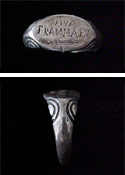
| Photo
Copyright 2005 |
| David
Xavier Kenney |
|
ROMAN LEGIONARY
RING OF THE II TRAIANA FORTIS (TRAJAN'S STRONG) ENGRAVED WITH VIVA
TRAIANA FS AND PALM |
Material:
Silver
Era: 2nd Century AD
Culture: Roman
Style: Roman
Origin: An Antiquities Dealer in Germany
On the band flanking the bezel there are stylized elephant heads which
are engraved in a Celtic style. This design may be due to recruits
coming from Gaul and this legion's long service in Egypt. |
|
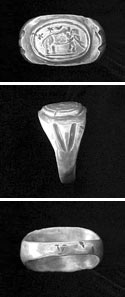
| Photo
Copyright 2005 |
| David
Xavier Kenney |
|
ROMAN LEGIONARY
RING OF THE V ALAUDAE (LARKS) |
Material: Silver
Era: 1st Century AD
Culture: Roman Provincial
Style: Roman
Origin: An Antiquities Dealer in Germany
The ring's bezel shows an elephant and an uncovered
legionary in the elephant's front quarters, this may be a representation
of this legion's Aquilifier (Eagle bearer). Overhead are two stars
(Dioscouri) and a bird. The bird should be an eagle but it appears
to be more similar to a lark. The bezel is flanked on the band by
engravings of elephant tusks. The V Alaudae had been the only Roman
legion to have the elephant as it's official emblem, this distinction
had been earned by successfully engaging a war elephant charge in
their first action. The V Alaudae was also the first legion to have
been recruited from foreigners (Gauls) outside of Italy (Raised
and financed by Julius Caesar). In essence the V Alaudae was the
world's first foreign legion, the fact that these legionaries were
from ancient Gaul (Modern France) is a rather interesting coincidence.
Copyright 2005 David Xavier Kenney |
|

| Photo
Copyright 2006 |
| David
Xavier Kenney |
|
ROMAN LEGIONARY RING OF THE V MACEDONIA |
Material: Silver and Jasper
Era: 2nd to 3rd Century AD
Culture: Roman Provincial
Style: Roman
Origin: An Antiquities Dealer in the Netherlands |
|
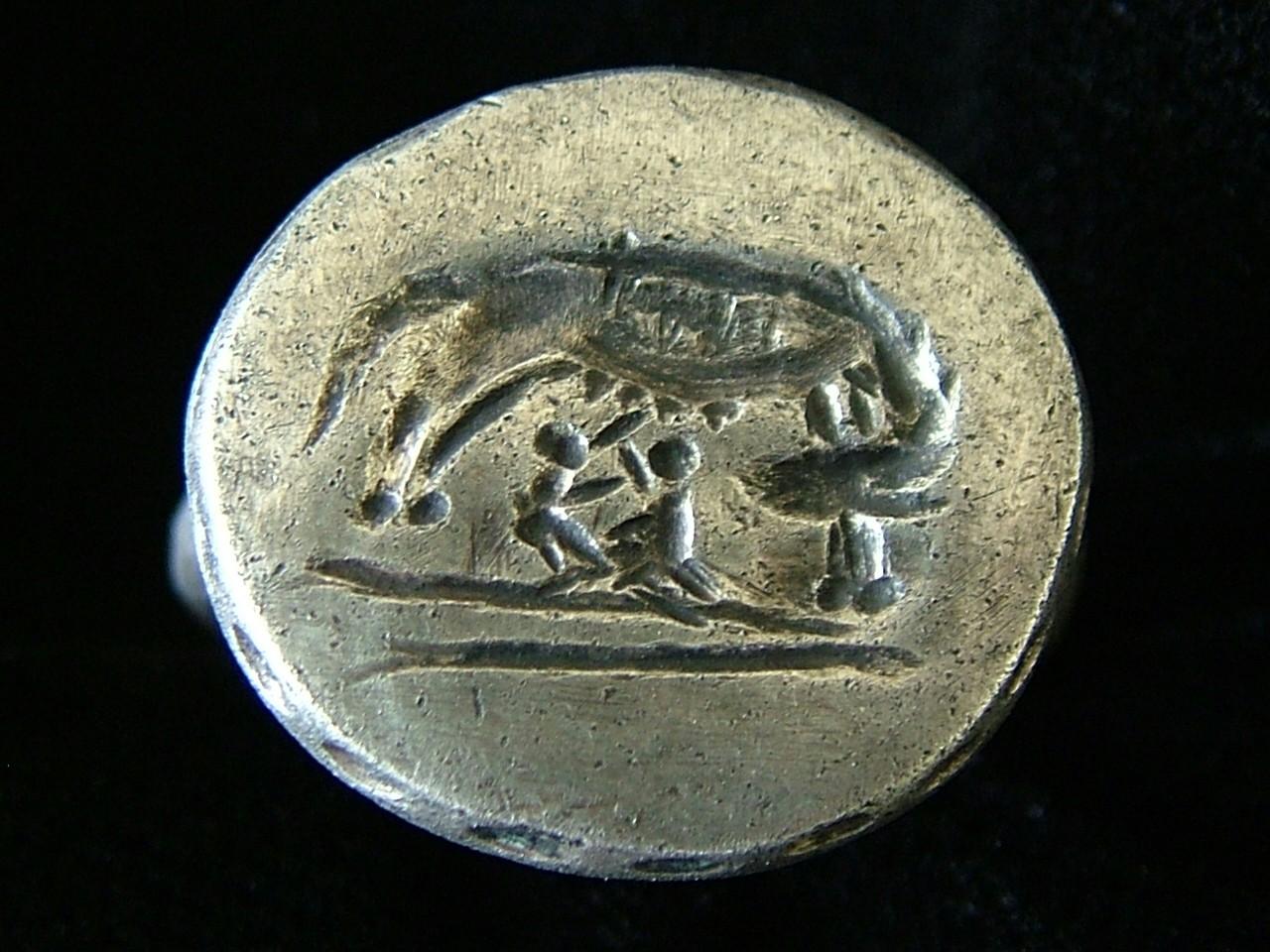
| Photo
Copyright 2008 |
| David
Xavier Kenney |
|
ROMAN LEGIONARY RING OF THE VI FERRATA |
| Material:
Silver and Lead Alloy
Era: 89 AD to 96 AD
Culture: Roman Provincial
Style: Roman Provincial
Origin: An Antiquities Dealer from Germany, From an Old German Collection
|
|
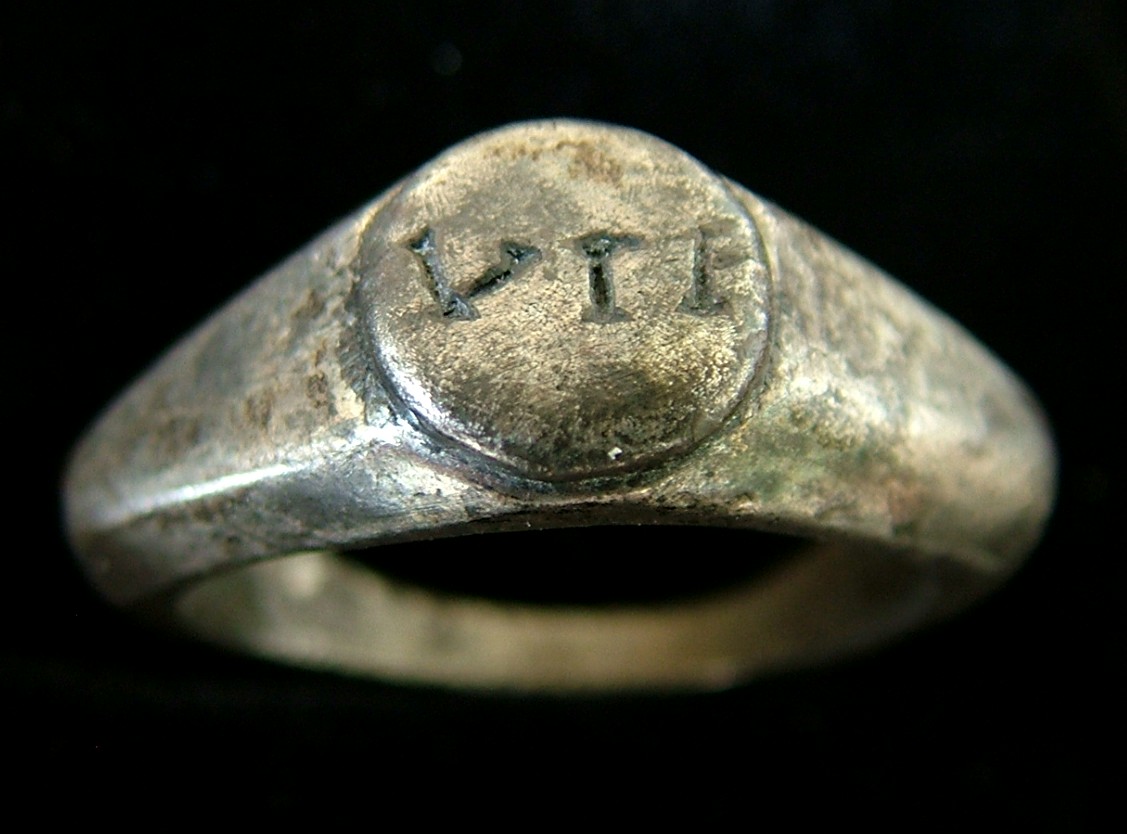
| Photo
Copyright 2008 |
| David
Xavier Kenney |
|
ROMAN LEGIONARY RING OF THE VI FERRATA |
Material: Silver and Mercury Alloy Gilded On Bronze with Traces Of Lead Inlay
Era: 89 AD to 96 AD
Culture: Roman Provincial
Style: Roman
Origin: An Antiquities Dealer in New Jersey
|
|

| Photo
Copyright 2008 |
| David
Xavier Kenney |
|
ROMAN LEGIONARY RING OF THE VI VICTRIX COMMEMORATING SERVICE ALONG HADRIAN'S WALL AND THE DUX LUCIUS ARTORIUS CASTUS'S ARMORICAN EXEPEDITION |
Material: Silver and Mercury Alloy
Era: Second Half of the 2nd Century AD to C. 210 AD
Culture: Roman Provincial
Style: Roman
Origin: An Antiquities Dealer in Germany, from an Old German Collection, found in England
|
|
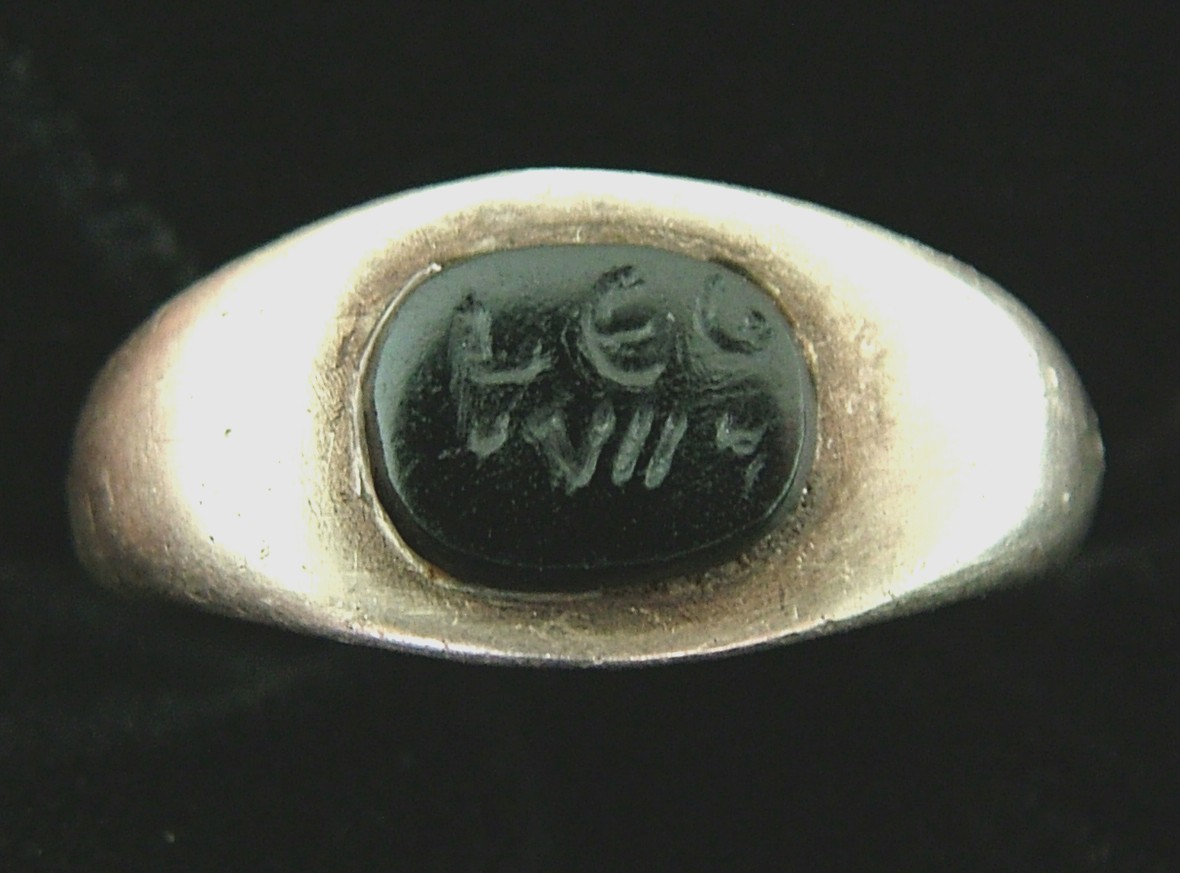
| Photo
Copyright 2007 |
| David
Xavier Kenney |
|
ROMAN LEGIONARY RING OF THE VII CLAUDIA |
Material: Silver and Onyx
Era: 2nd or 3rd Century AD
Culture: Roman Provincial
Style: Roman
Origin: An Antiquities Dealer in the Netherlands
|
|

| Photo
Copyright 2005 |
| David
Xavier Kenney |
|
ROMAN LEGIONARY RING OF THE IX HISPANIA |
Material: Bronze
Era: 117 AD to 138 AD
Culture: Roman Provincial
Style: Roman
Origin: An Antiquities Dealer In California
This bronze ring has; traces of silver alloy gilding, faint traces of gold gilding, faint traces of a type of lead/resin paste, and lead wash. Although it is not a particularly refined ring in it's original condition it was a highly elaborate.
First, I should mention that I have no doubt that this ring originated from some region of Germany or the Balkans, it is definitely not from the British Isles. There is an inscription and symbols for Britannia (that are not discussed here. There is a light inscription between the "I" and the "X" that shows bind letters for "HISPANIA", several of these can also be seen as "HAD" for HADRIAN, there is also a large figure taking a wreath from a small figure (a victory). There are suggestions with art on the "X" that this was for a victory over a Germanic tribe. The circle above the eagle's head is a solar disc that is also a round shield, there are figures inside the shield's boss and the letters "I" and bind letters "CS", this should stand for Julius Caesar as the founder of the IX Hispania. On the front of the eagle's head and on the eye there are the bind letters "I", "H", "P", "A", "T", and "M". This should stand for Emperor Hadrian Publius Aelius Traianus Hadrianus Pontifex Maximus. All this suggests that Legion IX Hispania had either been sent to the Balkans or had detachments in the Balkans under Hadrian, that it most likely was not as the revisionists now speculate destroyed in Britannia. Due to the additional effort with the artesian making an inscription with bind letters of Hadrian's full name and title on the eagle's head, then I think that this may suggest that the IX Hispania had in fact lost their Aquila (Eagle) at some point under Hadrian either in Britannia or Germania, and that it had been replaced, perhaps due to circumstances. At some point in the future I expect to have pictures posted of at least some of these inscriptions.
|
|

| Photo
Copyright 2005 |
| David
Xavier Kenney |
|
THE ICONOGRAPHY ON THIS RING IS CURRENTLY BEING RE-EXAMINED AS POSSIBLY OF AN EQUITES LEGIONIS
|
Material: Bronze
Era: 1st Century AD to Early 2nd Century AD
Culture: Roman Provincial
Style: Roman
Origin: An Antiquities Dealer in NJ
Info.
|
|

| Photo
Copyright 2006 |
| David
Xavier Kenney |
|
ROMAN LEGIONARY RING OF THE X FRETENSIS (FROM THE X EQUESTRIS)
|
Material: Silver
Era: Late 1st C. BC to Early 1st C. AD
Culture: Roman Provincial
Style: Roman
Origin: An Antiquities Dealer in Germany
|
|
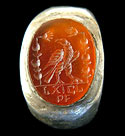
| Photo
Copyright 2007 |
| David
Xavier Kenney |
|
ROMAN LEGIONARY
RING OF THE XI CLAUDIA |
Material: Silver
and Carnelian
Era: 2nd to 3rd Century AD
Culture: Roman Provincial
Style: Roman
Origin: An Antiquities Dealer in the Netherlands
The eagle is flanked by two saluting signifier standards. One of the eagle's wing's has a heart shaped ribbon or laurel. This suggests that the XI Claudia may have had an entire Cavalry Ala (Wing of 500 Cavalrymen) permanently attached to it, that is at the time the ring was made.
|
|

| Photo
Copyright 2005 |
| David
Xavier Kenney |
|
ROMAN LEGIONARY
RING OF THE XI CLAUDIA |
Material: Silver
and Jasper
Era: 2nd to 3rd Century AD
Culture: Roman Provincial
Style: Roman
Origin: An Antiquities Dealer in California |
|
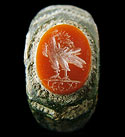
| Photo
Copyright 2007 |
| David
Xavier Kenney |
|
ROMAN WOMAN'S OR CHILD'S RING OF LEGION XI CLAUDIA |
Material: Bronze and Carnelian
Era: 2nd to 3rd Century AD
Culture: Roman Provincial
Style: Roman
Origin: An Antiquities Dealer in the Netherlands |
|

| Photo
Copyright 2005 |
| David
Xavier Kenney |
|
ROMAN LEGIONARY
RING OF THE XII FULMINATA (THE THUNDERING LEGION) COMMEMORATING THE BATTLE FOR SELECIA IN 164 AD |
Material: Silver
Era: 164 AD
Culture: Roman Provincial
Style: Roman
Origin: An Antiquities Dealer in Germany
|
|

| Photo
Copyright 2005 |
| David
Xavier Kenney |
|
ROMAN LEGIONARY RING OF THE XVI GALLICA (OF THE GAULS) AS AMPHIBIOUS LEGIONARIES
|
Material: Silver and Lead Alloy
Era: Late 1st C. BC to 70 AD
Culture: Roman Provincial
Style: Roman
Origin: An Antiquities Dealer in Germany
|
|

| Photo
Copyright 2005 |
| David
Xavier Kenney |
|
ROMAN LEGIONARY
RING OF THE XXI RAPAX |
Material: Silver
Era: Mid 1st Century AD to 92 AD
Culture: Roman
Style: Roman
Origin: An Antiquities Dealer in Germany
|
|
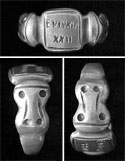
| Photo
Copyright 2005 |
| David
Xavier Kenney |
|
ROMAN LEGIONARY
RING OF THE XXII DEIOTARIANA |
Material: Silver
Era: 1st to Early 2nd Century AD
Culture: Roman Provincial
Style: Roman and Roman Provincial
Origin: An Antiquities Dealer in Germany
|
|

| Photo
Copyright 2006 |
| David
Xavier Kenney |
|
ROMAN LEGIONARY RING OF LEGION XXX CLASSICA PRIMA MARTIA |
Material: Silver
Era:Circa 50 to 42 BC
Culture: Roman
Style: Roman
Origin: An Antiquities Dealer in Germany
|
|

| Photo
Copyright 2005 |
| David
Xavier Kenney |
|
ROMAN LEGIONARY
RING OF THE XXX ULPIA TRAIANA VICTRIX, ENGRAVED WITH XXX ON A LEGIONARY
BRICK |
Material: Silver
Era: 3rd Century AD
Culture: Roman Provincial
Style: Roman
Origin: An Antiquities Dealer in Germany
|
|

| Photo
Copyright 2006 |
| David
Xavier Kenney |
|
ROMAN CAVALRY RING OF THE ALA II FLAVIA PIA FIDELIS MILLIARIA (WING OF THE SECOND FLAVIAN LOYAL AND FAITHFUL OF A THOUSAND)
|
Material: Silver
Era: 2nd Century AD
Culture: Roman Provincial
Style: Roman
Origin: An Antiquities Dealer in Germany
|
|
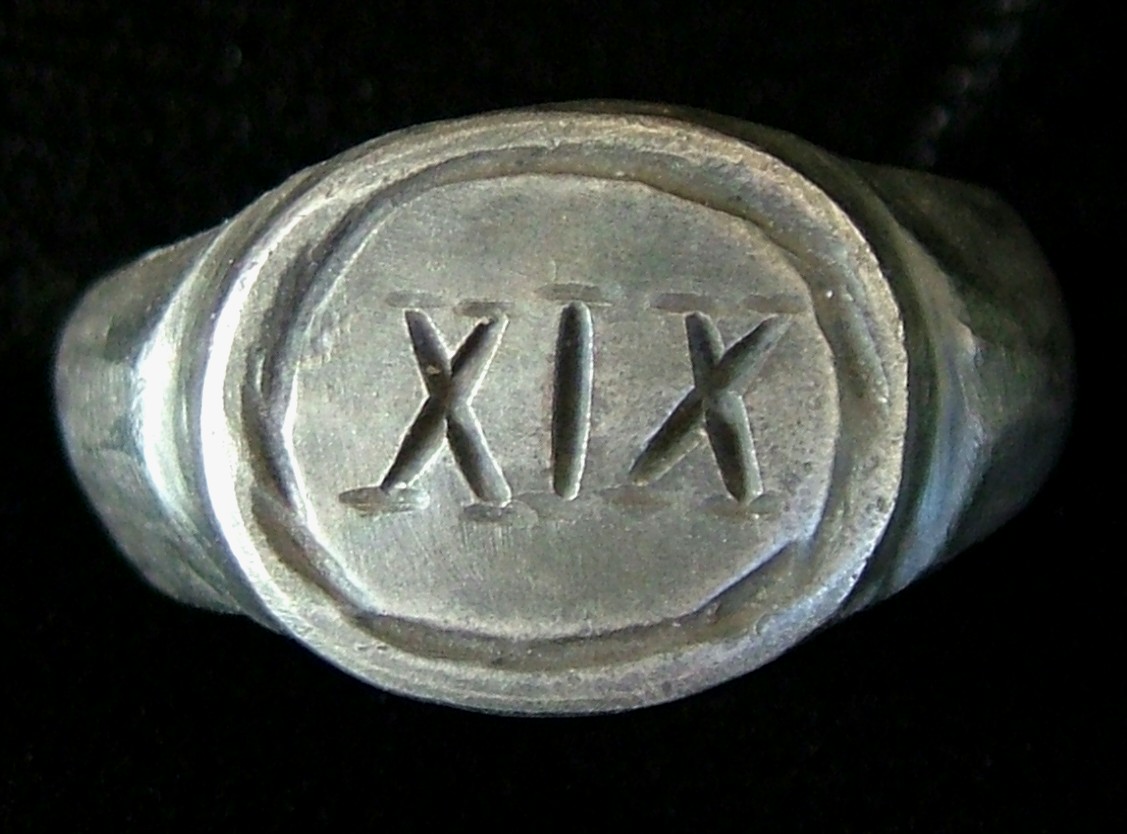
| Photo
Copyright 2008 |
| David
Xavier Kenney |
|
GERMANIC RING COMMEMORATING ARMINUIS AND THE CAPTURE OF THE EAGLE OF THE LEGION XIX AND THE DEFEAT OF VARUS'S LEGIONS AT THE TEUTOBURG FOREST |
Material: Silver and Lead Alloy
Era: C. 9 AD
Culture: Germanic
Style: Roman Provincial
Origin: An Antiquities Dealer in Germany
|
|

| Photo
Copyright 2008 |
| David
Xavier Kenney |
|
ROMAN RING OF THE MAKING OF THE SWORD OF MARS |
Material: Silver and Silver / Mercury Alloy
Era: 3nd to 4th Century AD
Culture: Roman Provincial
Style: Roman Provincial
Origin: An Antiquities Dealer in Germany, from an Old German Collection
|
|
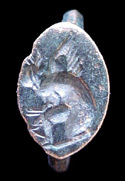
| Photo
Copyright 2006 |
| David
Xavier Kenney |
|
ROMAN RING OF VULCAN, MAKER OF JUPITAR'S THUNDER AND LIGHTNING BOLTS |
Material:
Bronze (With Traces Of Gold Gilding)
Era: 2nd to 3rd Century AD
Culture: Roman
Style: Roman Provincial
Origin: An Antiquities Dealer in California |
|

| Photo
Copyright 2006 |
| David
Xavier Kenney |
|
ROMAN CHRISTIAN SECT RING OF PANTHERA |
Material: Silver and Carnelian
Era: Early to Mid 2nd C. AD
Culture: Roman Christian Sect
Style: Roman Provincial
Origin: An Antiquities Dealer in the Netherlands
|
|
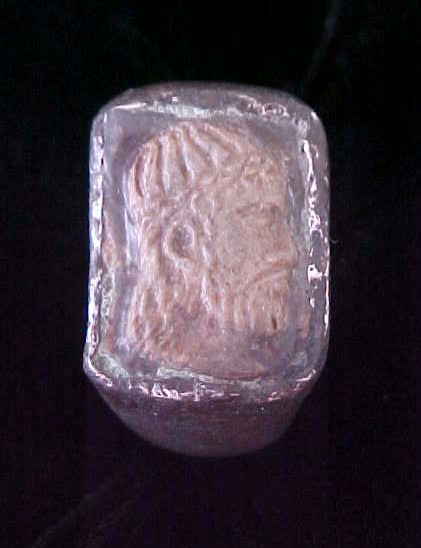
| Photo
Copyright 2006 |
| David
Xavier Kenney |
|
DACIAN CAMEO RING OF THE DACIAN KING BUREBISTA AND DECEBALUS |
Material: Bronze and Lead
Era: C. 117 AD
Culture: Roman Provincial
Style: Greek
Origin: An Antiquities Dealer in the Netherlands, purported to have originated from the Balkans
|
|
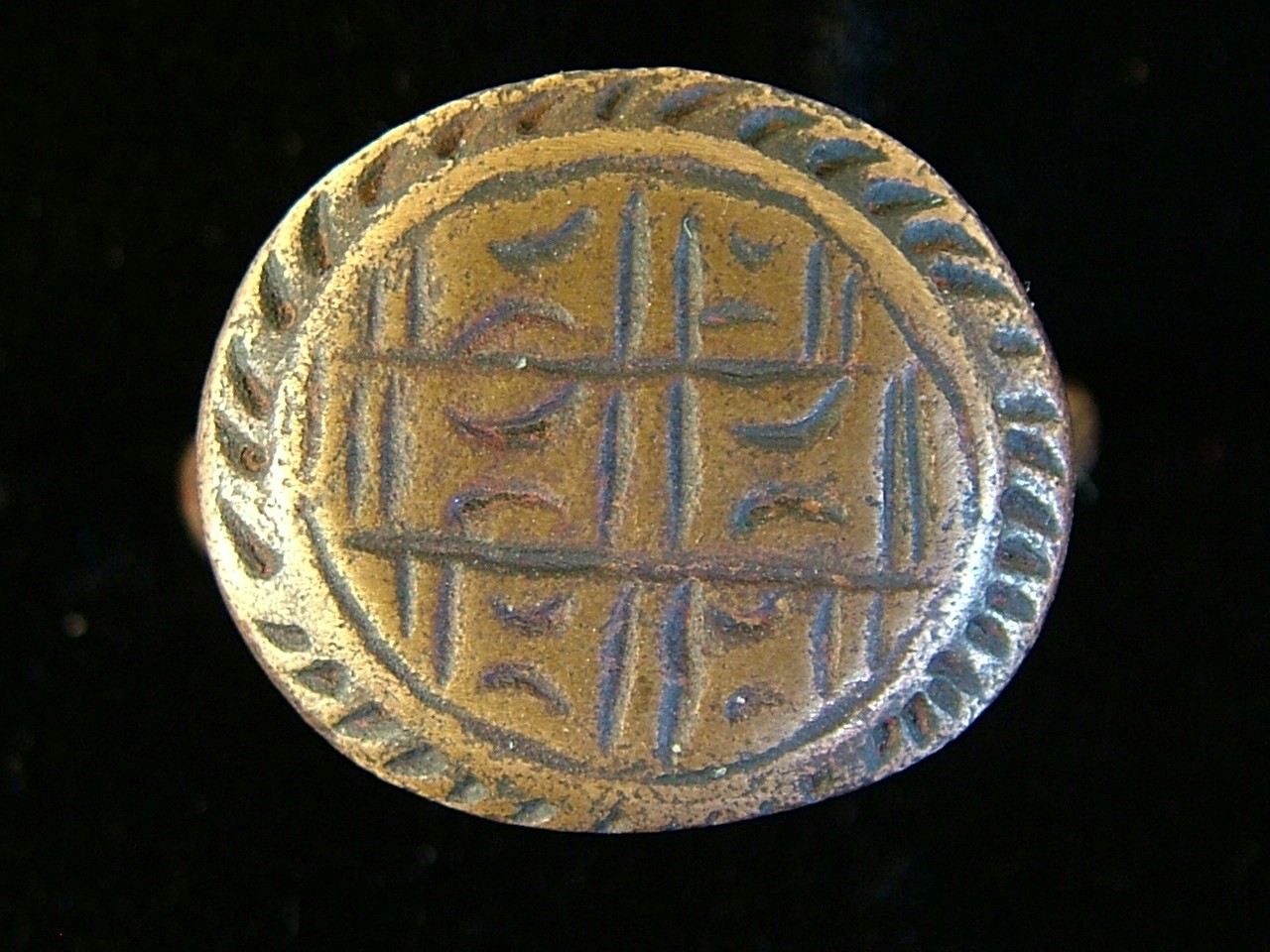
| Photo
Copyright 2008 |
| David
Xavier Kenney |
|
LION OF JUDAH DAVIDIC SHIELD RING OF THE SICARII OF THE 1ST JEWISH REBELLION |
Material: Bronze
Era: 67 to 73 AD
Culture: Judaic Sect
Style: Roman Provincial
Origin: An Antiquities Dealer in New Jersey
In April of 2012 I was contacted by a gentleman for a request for more info. about this ring, as well as compliments on the research. The gentleman claimed to be of a family that was of a Davidic and Solomonic secret society as custodians (guardians of that bloodline) descended from the original members of the Sicarii of the 1st C. AD. He wrote that he had been raised, schooled, and initiated in that society; but then due to the changing times it was now only an honorific family tradition. He sent me some info. that included images of three wax seal impressions belonging to his family, all three were very interesting, but one stood out, it is from an ornate late 19th C.seal with the name of that secret society and Canterbury, England. Canterbury is where he said the secret society had been headquartered at one time. The gentlemen claims that the most prominent symbology (Lion of Judah, three levels, ect.) on this ring is the same of some of his family's esoteric teachings, and that it most probably belonged to an ancient Sicari who had been of the same tradition. As I knew that the details on the inside of the ring's bezel are exceptional, I decided to do an even more detailed inspection. After that examination I came to the conclusion that there are several suggestions that the bronze used for the ring had been from melted down bronze objects - At least one being Judaic (possibly two) and the other from a Sicarii Roman trophy of the First Jewish Rebellion, perhaps! When I can get to it, I will post more images of some of the ring's details on the inside, as well as additional info.
|
|
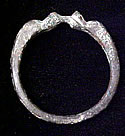
| Photo
Copyright 2005 |
| David
Xavier Kenney |
|
ROMAN THRACO
SARMATIAN DRAGON RING |
| Material:
Bronze
Era: 2nd Century AD
Culture: Roman Provincial
Style: Roman
Origin: An Antiquities Dealer In Illinois, purportedly from
Eastern Europe |
|
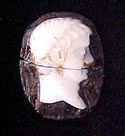
| Photo
Copyright 2005 |
| David
Xavier Kenney |
|
ROMAN AMETHYST
AND CITRINE (SARDONYX) IMPERIAL TYPE (EMP. CLAUDIUS) CAMEO |
Material: Amethyst
and Citrine
Era: 1st Century AD
Culture: Roman
Style: Roman
Origin: An Antiquities Dealer in Lebanon |
|

| Photo
Copyright 2006 |
| David
Xavier Kenney |
|
ROMAN INTAGLIO OF KING RUA OF THE HUNS |
Material: Carnelian
Era: 5th Century AD
Culture: Roman Provincial
Style: Roman
Origin: An Antiquities Dealer In England
Information to follow soon.
|
|
|
| |
| |
